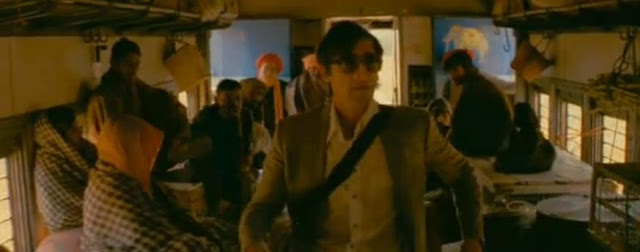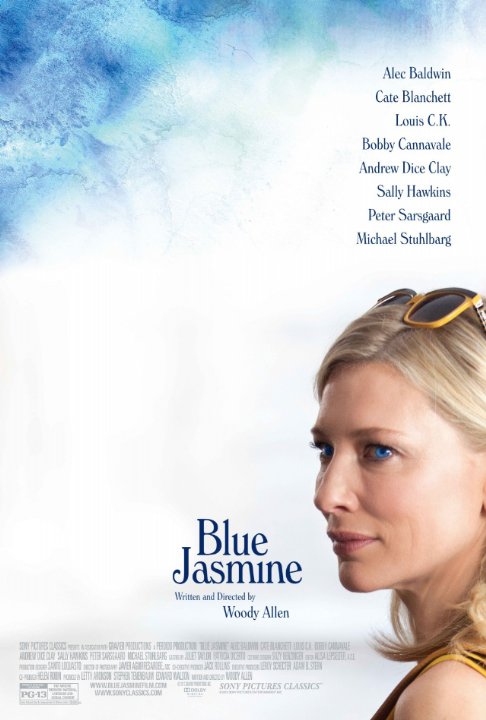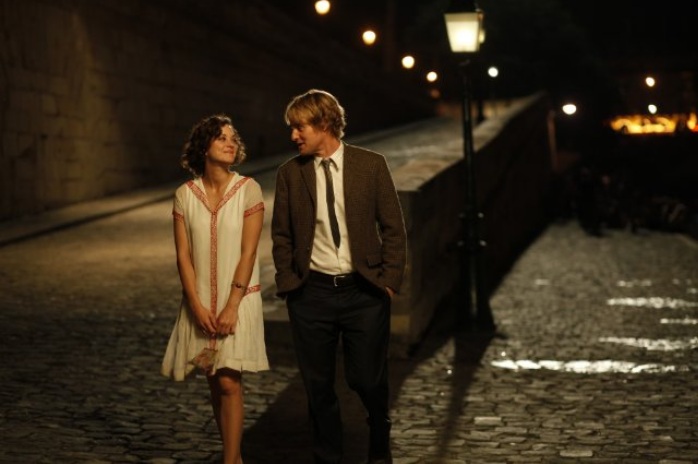This is a guest review by Steffen Loick and Ingrid Bettwieser.
At a hasty glance, movies often tell stories about traveling to talk about the processes of longing. Longing for far about places, for something new, for something unachieved. As it seems, what is inscribed in the narrative of traveling in the end is the need for change. The individual voyages the phantasms of the far, far away, to negotiate her- or himself’s identity. Traveling can be regarded ultimately as a coming of age journey, which holds many gendered and racialized subtexts of becoming.
In this essay, we ask how the genre of comedic travel-movies encodes gender-topics and how these are linked to the metaphor of a journey. Thereto we loosely compare the eponymic female protagonists of Woody Allen’s comedy Vicky Cristina Barcelona (2008) and the dandy-male protagonists of the comedy The Darjeeling Limited (2007) directed by Wes Anderson. Both movies follow socially close connected White, heterosexual US-Americans, who go on a trip to another continent, where they are afflicted by emotional disputes. We also ask how the particular female or male main ensemble is constructed in dialogue to the projected otherness of the countries they are visiting.
 |
| Vicky in the cab |
“A passing thing, now it’s over”: Gender, Identity, and Travel in Vicky Christina Barcelona
“Vicky and Cristina decided to spend their summer in Barcelona,” the male voice of the narrator in the opening sequence of Vicky Christina Barcelona declares. His introduction locates the following events in the “exotic” scenery of Spain and marks the seen protagonists by name, as they leave an airport with their luggage and get a cab. More importantly, the opening sentence determines the whole plot immensely: both protagonists are traveling.
The narrator’s voice will escort the complete storyline from the distance, commenting on it slightly mockingly and directing my impressions of the movie’s protagonists. This starts already on the cab ride to Barcelona, which serves as exposition: the White US-Americans Vicky and Cristina have known each other since college and are best friends. Using their affection for culture, the narrative structure of the movie defines and criticizes them as stereotypical. They are educated women, who want to travel beyond the touristic mainstream and are only divided by their different perspectives on love. Vicky represents the type of severe and inhibited female intellectual, who seems to be feminist but actually isn’t. She lives in a committed relationship with her White, autarchic fiancé. She “had no tolerance for pain and no lust for combat; she was grounded and realistic,” illustrates the narrator. Vicky goes on the journey because she’s doing a “Masters in Catalan identity.” Her research interests generate from her early worship of Gaudi’s architecture. She looks at Barcelona correspondingly with an ethnological, nearly colonial gaze; after all, she does research on a cultural group she is not herself a part of, whose language she barely speaks and who she reduces to touristy significant cultural markers. In contrast, Cristina “had yet broken up with another boyfriend and longed for a change in scenery,” the narrator explains. Cristina represents the sensual but deeply insecure artist, who hates her own art. Suffering is accepted by her as “an inedible component of deep passion.” Apart from this, she knows only what she doesn’t want: she strictly refuses Vicky’s life and love design.
 |
| Opening scene: Cristina in the cab |
Both are utterly successful as stereotypical tourists of culture: she dives into the “artistic treasuries” of Barcelona and meets in person the highly-educated painter, Juan Antonio, the Spanish seducer per se. Through his local knowledge, they can experience art and culture as distinguished insiders, and even Vicky is almost enchanted by him. A short, romantic and for her unusually passionate night is the reason for Vicky to fundamentally doubt her life concept. Even the spontaneous marriage with her suddenly appearing fiancé doesn’t seem to be able to stop the crumpling of her self-perception.
Her hostess, the older US-American Judy, accelerates this further. Judy feels trapped in her long-term marriage with a boring and rich man. An escape appears none but surrogated in the person of Vicky, who she sees as a younger emblem of herself. Meanwhile the exact opposite happens to Cristina, who is now in an ongoing sexual relationship with Juan Antonio. She begins to live with him and realizes that he is on highly explosive terms with his ex-wife, the Spaniard María Elena. In joining a polyamorous relationship with both, Cristina seems to live her own ideal: she lives the Avant-garde in Europe; she is the lover of physically desirable artists; she lives beyond the heteronormative, dichotomizing standard, which Vicky symbolizes. This is mainly established through the emotionally unstable but nevertheless strong character of María Elena. She is not only intimidating and choleric, but rather represents the type of the highly hypnotic muse. Thanks to her, Cristina gets self-confident about art; she begins to photograph while Juan Antonio and María Elena paint.
 |
| Final scene from Vicky Cristina Barcelona |
In the end everything stays as it was before. The journey, the summer in Barcelona, is for both women only an intermezzo. Vicky and Cristina are standing on moving stairs in the last sequence, which literally bring them back down. Vicky goes back to her husband, to her frame made of “seriousness and stability” and Cristina–who couldn’t dare commit to Juan and María–is still searching. None of them found a new self. None of them seems happy. The essence of the plot is brilliantly stated by Vicky’s character, “It was a passing thing; now it’s over.”
In conclusion, one must point out that Vicky Cristina Barcelona generates its immense comedic potential from mocking its stereotypical unemancipated female main characters. The end of the film especially shows the intellegence of the story: nothing changes for Vicky and Cristina. They do not find a spiritual solution; everything stays the same.
 |
| Prelude scene from The Darjeeling Limited |
“I want us to make this trip a spiritual journey where each of us seek the unknown”: Clash of masculinities and postcolonial forgiving in The Darjeeling Limited
Our next movie starts off with an emblematic taxi ride again. This time, in a prelude to the main plot, an American business man is turbulented through hectic traffic and ongoing day-to-day routines of an unknown Indian mountain town. Bollywood-style music is hammering as a ruthless and emotionally unaffected taxi driver speeds to the local train station and leaves the American to clutch the front seat. Through the steering wheel we can see the driver’s small picture relics, signs of religious appreciation. Having arrived at the station, the American hastens straight to the ticket counter without a word to the obviously insulted driver and past a waiting line of locals. In this scene, central subjects of the movie are encoded: The hegemonic White western masculinity which is contrasted by the suspicious subaltern male, who for most of the time is captured in local customs and therefore cannot speak (be understood) as well as the mystified female postcolonial cultural landscape.
 |
| Villagers demonstrating their gratefulness |
In the course of the movie, we follow the family dynamics of three US-American upper-class brothers who take a train ride, a “spiritual journey,” through the Darjeeling district in eastern India. We learn that there is a deceased father, whose luggage they symbolically carry with them, and more importantly, as things unfold, a mother who has left “her boys” in order to work as a nun in an Indian convent. Every time the subject of the mother turns up, the three collectively consume pain killers to “get high.” In short, resulting from being brought up with this incompletion, the brothers are incapable of living up to the proper standards of functional adult masculinity: The eldest holds scars from a recent suicide attempt; the second fled his pregnant wife and the responsibilities of fatherhood; and the youngest is unable to get over his ex-girlfriend. On this so-called “spiritual journey,” the “spiritual” can be paralelled with the missing mother-figure and, more generally, with the “mystic” and “unknown” femininity that is being ascibed to the postcolonial country. Only through the journey can the brothers attain their proper heterosexual masculinities.
 |
| Peter Whitman entering the train through the lower class compartments, passing the “silent” but watching subaltern |
As the train sets off and as we are getting more involved with the brotherly conflicts, the only other female character with a name (and at the same time the only local with a personality) is introdced. Rita, the train stewardess, soon catches the attention of Jack Whitman who then brashly has sex with her in the bathroom. Symbolically speaking, the Indian postcolonial cultural space is being re-appropriated by this act.
Througout the journey, the three brothers are contrasted by the “other” Indian male who is not complicit or unruly and does not understand the realms of western hegemonic masculinity. Therefore, he appears suspicious and has neither personality nor name. There is the overly business-like, stiff chief stewart (whose sanctions are ignored), the shoeshine boy (who steals the expensive shoe), “laughing” boys (“assholes”), crooked salesmen (who don’t really know what they are selling), and finally cricket players (who play cricket with a tennis ball).
 |
| Scene from The Darjeeling Limited |
With these competing (but depicted as inferiour) modes of masculinity, the “spiritual journey” for the attainment of functional manliness can only be completed by a heroic act. The brothers accidentally observe how three local boys tip over into a river as they’re fishing, and they are instantly carried away by the stream. Each brother bravely jumps in after a boy to find that they could only save two. Peter couldn’t bring back “his” boy alive.
After scenes of relatives mourning in the nearby village, the brothers are invited to attend the boy’s funeral by the grieving father. With this symbolic act of acknowledgement by a local subaltern male, the Westeners can reconcile with their male identities.
 |
| Rita marks Jack “spiritually” |
Despite the rescue of two local boys, Peter blames himself for the loss of the third. Only the news of the birth of a baby boy can make amends for this and unite the brothers in male bonding so that they are finally ready to encounter their mother.
At the peak of a Himalayan mountain (and the movie) the three brothers meet their surprised mother in a convent and confront her with several questions concerning her disappearance and the abandonment of her sons: “Why didn’t you come to dad’s funeral?” … “What are you doing here?” … and “What about us?”
 |
| Rita looking for Jack |
Factually she explains: “I didn’t want to. I live here.” And, pointing at a statue of Mother Mary, she withdraws herself from the patriarchal demands of motherhood: “You are talking to her. You are talking to someone else. You are not talking to me. I don’t know the answers to these questions. I don’t see myself this way.”
Regardless of this final demonstration of female agency, one of the overall implications of the movie is the damage done by the cancellation of motherly liability–which is also a predominant subject in Western educational discourses. Being set in the postcolonial imaginary, the “lost” here is re-appropriated by masculinist bonding and the subordination of the subaltern “other.”
Steffen Loick is doing research about the relationship between gender identity and body optimation at Ludwig-Maximilian University, Munich Germany, and Ingrid Bettwieser studies history and literature at Freie Universität, Berlin Germany.





















